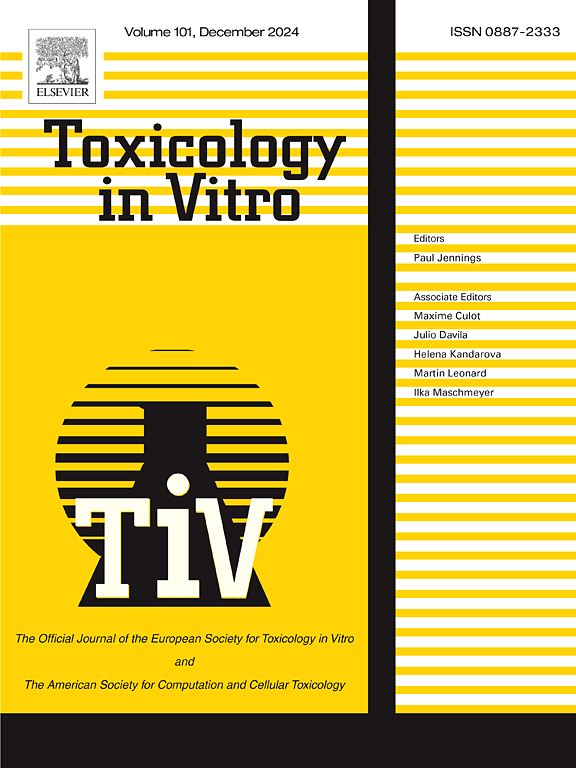双酚 AF 对体外骨骼肌功能和分化的影响
IF 2.6
3区 医学
Q3 TOXICOLOGY
引用次数: 0
摘要
各种环境化学物质已被确认为代谢性疾病的诱因。双酚 AF(BPAF)是双酚 A 的替代品,它与人体葡萄糖代谢的变化和 2 型糖尿病的发病率有关。然而,其作用模式仍不清楚。考虑到骨骼肌是葡萄糖利用和胰岛素抵抗发展的主要组织,但在毒理学评估中却大多被忽视,我们研究了双酚 A 对骨骼肌功能和分化的影响。我们研究了双酚 AF(0.01-10 μM)在高血糖、胰岛素刺激和肌肉收缩过程中对葡萄糖摄取、胰岛素反应、活性氧(ROS)产生、细胞内钙和肌细胞分化的影响。我们使用了分化成肌管的大鼠肌母细胞系 L6 和小鼠原代离体肌纤维。在肌细胞管和收缩的成肌纤维中,双酚 AF 增加了线粒体 ROS。肌管的基础葡萄糖摄取量增加,而细胞对胰岛素的反应能力下降。此外,在发育中的肌管中,双酚 AF 会导致分化标记下调,肌管结构的形成也会受损。这些影响主要是在 10 μM 浓度下观察到的,该浓度明显高于报告的人体接触浓度。这些结果使人们深入了解了双酚 AF 在破坏骨骼肌新陈代谢方面的潜在危害。所开发的体外方法有望在未来用于评估新化学品及其混合物。本文章由计算机程序翻译,如有差异,请以英文原文为准。
The impact of bisphenol AF on skeletal muscle function and differentiation in vitro
Various environmental chemicals have been identified as contributors to metabolic diseases. Bisphenol AF (BPAF), a substitute for bisphenol A, has been associated with changes in glucose metabolism and incidence of type 2 diabetes mellitus in humans. However, its mode of action remains unclear. Considering that skeletal muscle is the primary tissue for glucose utilization and the development of insulin resistance, yet largely neglected in toxicological assessments, we investigated the impact of BPAF on skeletal muscle function and differentiation.
We examined the effects of BPAF (0.01–10 μM) on glucose uptake, response to insulin, production of reactive oxygen species (ROS), intracellular calcium, and myocyte differentiation, during hyperglycemia, insulin stimulation, and muscle contraction. We used the rat myoblast cell line L6 differentiated into myotubes, and murine primary isolated muscle fibers.
In myotubes and contracting adult fibers, BPAF increased mitochondrial ROS. Basal glucose uptake was increased in myotubes while cells' ability to respond to insulin was decreased. Additionally, in developing myotubes, differentiation markers were downregulated with BPAF, along with impaired formation of tube structures. These effects were primarily observed at 10 μM concentration, which is markedly higher than reported human exposure concentrations.
The results provide an insight into potential hazards associated with BPAF in terms of metabolic disruption in skeletal muscle. The developed in vitro methods show promise for future usage in assessments of new chemicals and their mixtures.
求助全文
通过发布文献求助,成功后即可免费获取论文全文。
去求助
来源期刊

Toxicology in Vitro
医学-毒理学
CiteScore
6.50
自引率
3.10%
发文量
181
审稿时长
65 days
期刊介绍:
Toxicology in Vitro publishes original research papers and reviews on the application and use of in vitro systems for assessing or predicting the toxic effects of chemicals and elucidating their mechanisms of action. These in vitro techniques include utilizing cell or tissue cultures, isolated cells, tissue slices, subcellular fractions, transgenic cell cultures, and cells from transgenic organisms, as well as in silico modelling. The Journal will focus on investigations that involve the development and validation of new in vitro methods, e.g. for prediction of toxic effects based on traditional and in silico modelling; on the use of methods in high-throughput toxicology and pharmacology; elucidation of mechanisms of toxic action; the application of genomics, transcriptomics and proteomics in toxicology, as well as on comparative studies that characterise the relationship between in vitro and in vivo findings. The Journal strongly encourages the submission of manuscripts that focus on the development of in vitro methods, their practical applications and regulatory use (e.g. in the areas of food components cosmetics, pharmaceuticals, pesticides, and industrial chemicals). Toxicology in Vitro discourages papers that record reporting on toxicological effects from materials, such as plant extracts or herbal medicines, that have not been chemically characterized.
 求助内容:
求助内容: 应助结果提醒方式:
应助结果提醒方式:


